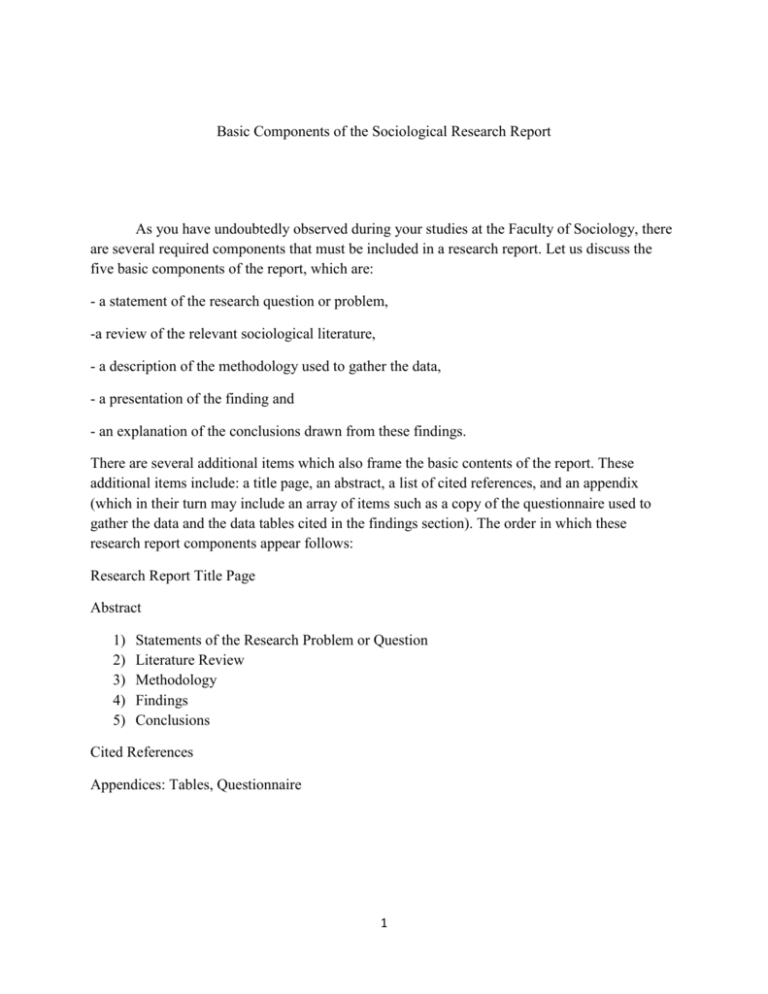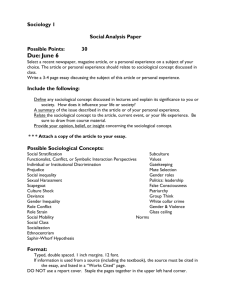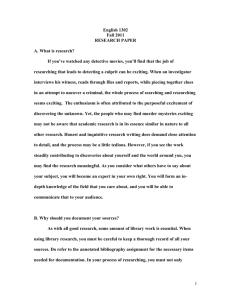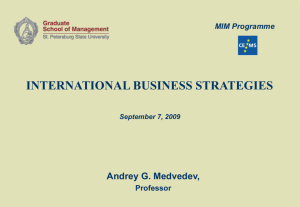Basic Components of the Sociological Research Report As you
advertisement

Basic Components of the Sociological Research Report As you have undoubtedly observed during your studies at the Faculty of Sociology, there are several required components that must be included in a research report. Let us discuss the five basic components of the report, which are: - a statement of the research question or problem, -a review of the relevant sociological literature, - a description of the methodology used to gather the data, - a presentation of the finding and - an explanation of the conclusions drawn from these findings. There are several additional items which also frame the basic contents of the report. These additional items include: a title page, an abstract, a list of cited references, and an appendix (which in their turn may include an array of items such as a copy of the questionnaire used to gather the data and the data tables cited in the findings section). The order in which these research report components appear follows: Research Report Title Page Abstract 1) 2) 3) 4) 5) Statements of the Research Problem or Question Literature Review Methodology Findings Conclusions Cited References Appendices: Tables, Questionnaire 1 Research Report Title Page. A title is created which captures the essence of the research question. The author’s name(s), institutional affiliation, and completion date are also usually included on the title page. If funding was provided to support the research , the granting agency is also identified. If the report is a paper to be presented at a professional meeting, then the organization, city and meeting date are included as well. Abstract. The abstract is a brief statement summarizing the research question, its relevance to the literature, the primary date gathering method, as well as key finding and conclusions. The abstract is normally no more than one single-spaced page. It is often no longer than 100 -150 words. Statement of the Research Question or Problem. This is the first major component of the report. It is the introduction to the research project. This section gives the reader a brief overview of what was researched and why it was important to do, how the findings would contribute to the existing research literature, to theory development, as well as how it may contribute to improving our society. The length of this introduction varies greatly. It usually one to three pages long. Literature review. The literature review accomplishes several tasks. First, it demonstrates that the researcher has a thorough understanding of the relevant issues gleaned from the existing research findings. Second, it establishes the relevance of the current project, i.e., building a case which demonstrates that the current research question is the next logical extension of the ongoing work being conducted in the substantive research area under consideration Research methodology. The methodology section describes, in detail, the research methods employed in conducting the project, e.g., how a mail questionnaire was used and how the sample was drawn, the response rate, what was done to maximize the response rate, and what limitations result from the sampling procedures and the methodology employed. This is also where variables are operationalized and where a description of measurement techniques appears. If hypothesis were developed and tested, a discussion and presentation of them is included this section of the report. Findings. There are two major sub-categories. First, the researcher is expected to demographically describe the sample, e.g., make up by gender, age, income, education, and so forth. The reader will thus obtain a picture of the respondents upon whom the findings are based. The second sub-category of the findings section is devoted to the substantive finding, i.e. discussion of the tabulations of how the respondents answered the relevant interview questions and a presentation of the relevant data which contributes to answering the research question. Included in this section are relevant applications of variable means, standard deviations, chisquare test results, correlation coefficients, multiple regression, ANOVA, and t-test result. It should be noted that much social research utilizes nothing more than frequency distributions, descriptive statistics, and elementary crosstabulations, e.g., comparing gender’s 2 possible influence on income. Some of us also use chi-square, correlation coefficients, multiple regression analysis, ANOVA and t-tests but only when it makes sense to do so. The good researcher does not use every statistical procedure in the book just because these tools exist. The good researcher wisely selects those which are most appropriate to the task at hand. Conclusions. In this section of the report, the researcher summarizes key finding, interprets their meaning, and, when possible, applies a sociological paradigm to add greater clarity to the interpretation of the finding. She may also discuss their practical application, make suggestions for future research, note the limitations of the present findings, and indicate any methodological implications discovered during the project. Cite References. The American Sociological Association format is followed when providing the bibliographic details of the cited references. ASA format essentially means alphabetically listing references, last name, followed by first. The date of the publication is next, followed the titles, city and publisher. In the case of a journal article the references substitute the name of the journal for the publisher, excludes city, and also adds the issue number and pager numbers. For example: Rezaev, Andrey V.(1996). Reflections on the three P’s of Russian Higher Education: Philosophy, Practice, Prospects. ISACT Press, Ivanovo Rezaev, Andrey and Olga Malets. (2012). “Higher Education Studies: Toward a New Scholarly Discipline” in W.R. Allen, R. Teranishi and M. Bonoush-Hammarth (Eds.) As the World Turns: Diversity and Global Shifts in Higher Education Theory, Research and Practice. Emerald Group Publishing, United Kingdom Rezaev, Andrey (2010) “Bologna Process: On the way to a Common European Higher Education Area”, in The International Encyclopedia of Education, 3rd Edition, edited by Barry McGaw, Penelope Peterson and Eva Baker, Elsevier Appendix. Tables are listed in the Appendix. They should be numbered consecutively, in the order in which they are referred to in the text. For example, Table 1 should include frequency distributions for the demographic variables. Table 2 should include frequency distributions for the substantive variables and Table 3 should include the crosstabulations which compare independent and dependent variables for possible relationships. A copy of the data gathering tool should also be included in the Appendix. For example, whether you used a mail-questionnaire, an observation guide, or a content analysis form, include a copy in the Appendix. 3







